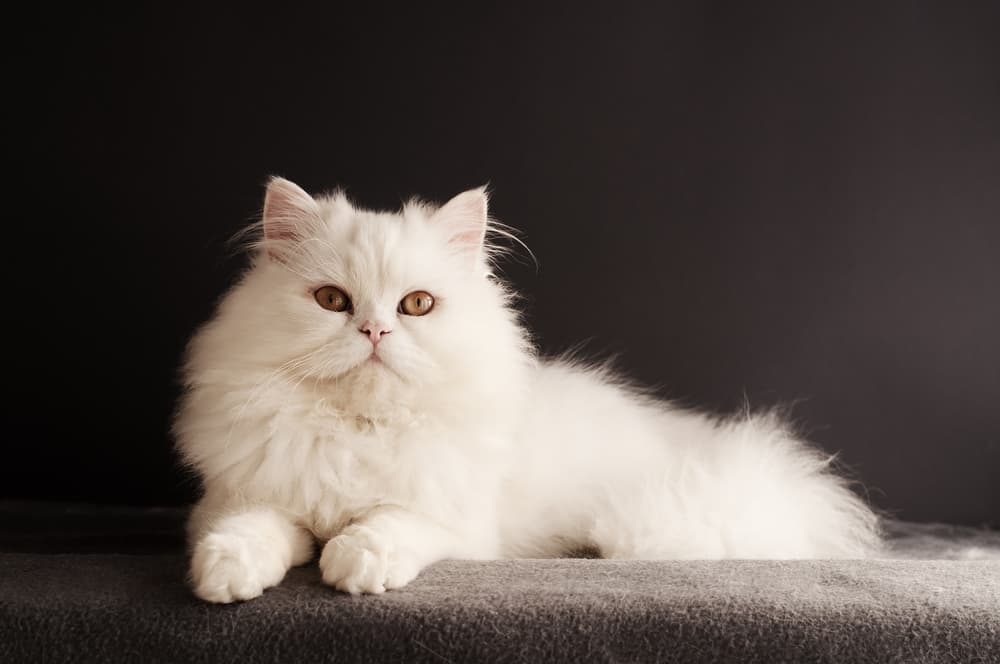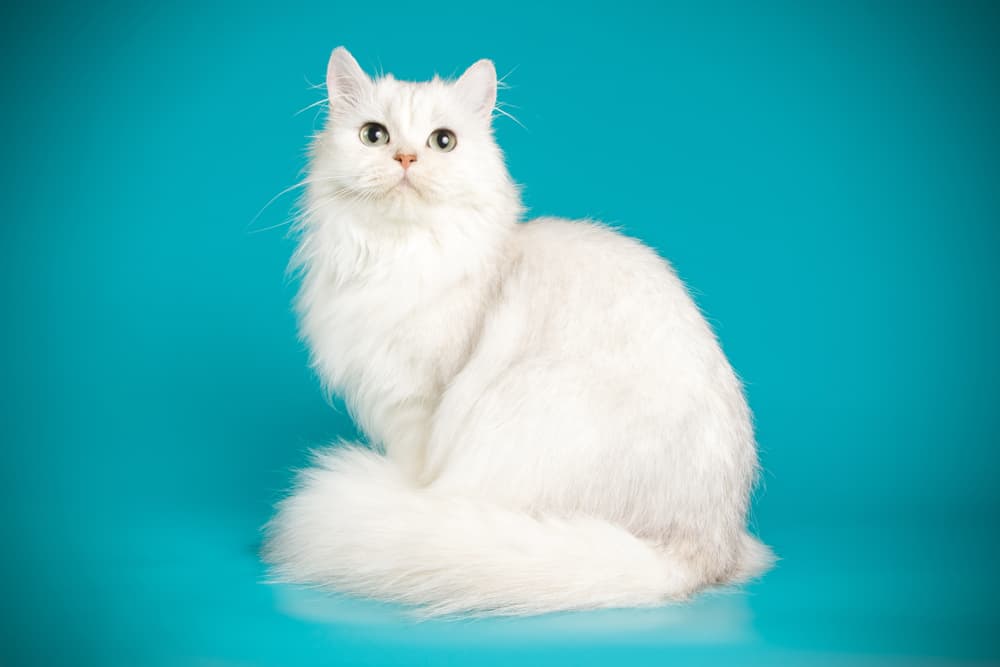Persian Cat

Breed Details
- Average Height: 10-15 inches
- Average Weight: 7-12 lbs.
- Coloring: White/silver, black, red, blue and cream solid colors; calico, bi-color, tabby, parti-color, smoke and shaded, silver and gold, and Himalayan
- Coat Type: Long and silky with an undercoat
- Average Lifespan: 12-17 years
-
Key Personality Traits:
Affectionate
Calm
The regal-looking Persian cat is the ultimate feline for lap-sitting and couch cuddling. With her elegant long, silky hair, distinctive round face, and sweet personality, this feline is among the most popular cat breeds in the country.
Anyone willing to dedicate the time and effort to maintain her thick coat and wellness needs will be rewarded with a gorgeous cuddle buddy who is loyal and loving.
Keep reading to learn everything you need to know about this dignified and delightful purebreed.
History and Origin
These cats are believed to have originated in Mesopotamia, later known as Persia (modern day Iran), hence their namesake. An Italian nobleman named Pietro della Valle is among the merchants who brought Persian cats from the Middle East to Western Europe in the 1600s. During her reign, Queen Victoria was known to be fond of these gentle cats.
In late 19th century America, they gained popularity in the cat show circuit, quickly upstaging another long-haired beauty, the Maine Coon. Persian cats were among the first to be registered by the Cat Fanciers’ Association during its formation in 1906.
Types of Persian Cats

As these longhair cats were so sought after, countless varieties of the breed came into existence. Among them are Doll Face, Himalayan, and Teacup Persian Cats.
The Doll Face Persian is considered to be the traditional version of the breed, with its charming, diminutive face and striking eyes. One of the benefits of a Doll Face Persian is that they have regular sized noses, so they don’t suffer from breathing issues faced by other Persians.
Teacup Persians, while immensely adorable, are bred to be tiny and are the smallest Persian cats. Think twice before getting one of these fluff balls because they are not only expensive, but they tend to have more health issues, including difficulty breathing.
Persian cats in the Himalayan division, also known as Colorpoint Longhair, have a distinctive appearance as they are bred from a Siamese and a Persian cat. These cats have strikingly beautiful blue eyes and a white or fawn-colored coat, with their face and extremities in a different color (similar to that of a Siamese).
Persian Cat Physical Characteristics

The traditional Persian cat is identified by its distinctive features—from its expressive circular eyes to its round face and body. Their faces are flat with small ears and short noses.
This breed also features luxurious long hair, a ruff around the neck, and a low-slung, bushy tail. Their legs are sturdy with large paws. The Persian’s coat comes in 60 different color variations, the most desirable including solid, tabby, calico, bi-color, smoke and shaded, silver and gold, and Himalayan.
While female Persian cats weigh 7 to 10 lbs, males are typically between 9 to 14 pounds. These medium-sized felines can get up to 10-15 inches tall and reach adulthood around the age of two.
Persian Cat Personality Traits

If you are seeking an active cat that chases wand toys or dances to feather teasers, the Persian cat may not be right for your family. This lap cat, sometimes referred to as “furniture with fur,” likes nothing more than to curl up on a warm window sill or cuddle up next to her human on the couch. You won’t have to worry about her climbing bookshelves or destroying furniture.
“Persians are typically gentle, quiet, sweet natured cats that get along well with most people and situations,” says Kirsten Kranz, director of Specialty Purebred Cat Rescue (SPCR). These cats do well with children, so long as they are not surrounded by loud noises. According to Kranz, “respectful, gentle children that are guided by their parents would probably be fine with them.”
When introducing a Persian cat to your family, keep in mind that these animals can be discerning. They reserve attention to only those in the immediate family and close friends. If you have other pets, especially dogs, a well-socialized Persian may be better equipped to handle them.
Persian Cat Care Guide

Persian cats need quite a bit of commitment to maintain their good looks and health. Pet parents who are blessed with their presence can expect to spend quite a sum of money on grooming and healthcare. Read on to learn ways to provide your fluffy friend with the best quality of life possible.
Diet and Nutrition
Cat food that is high in protein and fiber and low in fat is ideal for your Persian. They may be picky eaters, but they are content once they find what they like, whether the food is wet, dry, or a combination of both.
Because these cats tend to be lazy, overfeeding can cause weight gain. Combat obesity by feeding small amounts twice daily rather than leaving food out all day. Flat-faced animals sometimes have trouble eating food in certain shapes, so consult with your veterinarian to find the best diet for your feline friend.
Exercise and Activity
Persian cats don’t require much exercise. “They tend to be low energy and don’t need much in the way of creative exercise,” says Kranz. “Playing is always a good idea, but they tend to be couch potatoes.”.
According to Dr. Wailani Sung, of the Behavior Specialty Clinic at the San Francisco SPCA, Persian cats aren’t athletic or energetic because of their “squat, heavy build compared to other breeds”. However, she notes, “All cats benefit from enrichment and exercise to keep them mentally and physically healthy.” Persian cats can also be playful or more energetic when they are young.
Grooming
Daily brushing is required to maintain the shine and vigor of a Persian’s coat. This also prevents tangles and matting. Additionally, because of their flat faces, they tend to get stains from excessive watering from their eyes that need to be wiped and cleaned regularly. “They need to have their faces cleaned, such as in between the skin folds on their face and discharge from their eyes,” says Sung.
Bathing is necessary once or twice a month to prevent dirt and litter from getting stuck. Some Persian pet parents opt for regular haircuts to prevent matting and feces or litter from getting stuck to the rear end. These can lead to discomfort and skin infections. Their nails need to be clipped every two weeks.
Persian Cat Health Issues

According to Sung, the round, squished face of a Persian is a source of health issues. These include:
Difficulty Breathing: Due to a Persian’s flat face shape, some cats may have difficulty breathing, especially Teacup Persians. These cats should be monitored during exercise and kept cool on high heat days.
Ocular Discharge: Persians may develop watery eyes—again, caused primarily by their face shape. That’s why regular wiping and cleaning is necessary.
Polycystic Kidney Disease: “Polycystic kidney disease (PKD) is an inherited disease. It can eventually result in chronic renal failure,” says Sung. She recommends that pet parents take their cats for annual exams and get diagnostic tests like bloodwork and ultrasounds to look at their kidneys.
She notes that the condition may not cause significant problems until the cat is older. For those concerned about their kitten being predisposed to kidney disease, Sung recommends pursuing a DNA test.
Periodontal Disease: Persian cats have teeth that are not positioned correctly—called malocclusion, says Sung. This can cause dental disease. In addition to annual check-ups, your Persian will benefit from yearly oral examinations and dental cleanings.
Interesting Persian Cat Facts
The Persian cat was the first breed to be showcased in the world’s first cat show, held in 1871 at the Crystal Palace in London. The event drew close to 20,000 visitors and Persian cats took home the “Best in Show” title.
Marilyn Monroe had a white Persian cat named Mitsou.
Florence Nightingale had 60 cats during her lifetime, including a Persian named Mr. Bismarck.
Persian cats appear in the world’s largest cat painting, named My Wife’s Lovers, featuring both Turkish Angoras and Persian cats. The 6-foot by 8.5-foot artwork by Carl Kahler can now be viewed at the Portland Art Museum in Oregon.
Persian Cat Adoption Tips and Things to Consider

If you are considering adding a Persian cat to your family, the best place to find them is with breed specific rescues or online. “People are not very likely to find Persians in shelters or, if they do, the cats will be in very poor condition,” says Kranz. “They can be found with breed specific rescues like ours or on places like Petfinder.org.”
Below are a few Persian cat rescues based in the United States:
- Specialty Purebred Cat Rescue, serving the Midwest
- Purebreds Plus Cat Rescue, based in Southern California
- Persian & Himalayan Cat Rescue, based in Northern California
Persian Cat FAQs
These high-maintenance cats require regular grooming and a lot of attention in order to keep them healthy and happy. Before bringing a Persian cat into your life, make sure you have all the answers to the most frequently asked questions about this cat breed.
How Long Do Persian Cats Live?
Persian cats can live up to 17 years.
Are Persian Cats Hypoallergenic?
No, they aren’t hypoallergenic and can cause allergies due to their long coats that are full of dander and protein (Fel d 1) deposits from their saliva during grooming.
Do Persian Cats Shed?
Yes Persian cats do shed, but daily brushing can prevent excessive shedding and matting.
Are Persian Cats Playful?
Persian cats tend to have short bursts of energy and they are more playful in their early years.
Pictures of Persian Cats
Persian cats are beautiful felines that have distinct features, fluffy hair, and big eyes. We could stare at pictures of Persian cats all day long. If you feel the same way, browse our gallery to see some photos of these gorgeous pets.
























